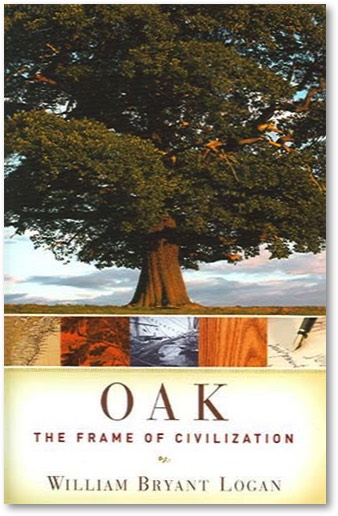
Musings » Oak: the frame of civilization


New York
W.W. Norton 2005
William Bryant Logan has approached his topic in the Tolstoyan manner: beginning at the periphery and gradually coming to the centre. This is not a monograph or treatise but an almost lyrical journey through the by-ways of history. The oak tree persisted in its habitats for millennia by virtue of not having very specialized needs or making complex demands on the eco-system. This allowed it to flourish even in less than ideal circumstances.
Once the glaciers receded oak trees rapidly spread to new niches. The earliest human beings soon learned to manage the trees in what we can now see are most sophisticated ways, coppicing the trunks or pollarding the branches to encourage new growth in the right places. The acorns supported life in many populations, not just the Native Americans with whose methods we are familiar in California. There are parts of the world in which the acorn is still an important item of diet.
One could not possibly have imagined the wealth of extraordinary tangential information related to oak trees and their role in human history before opening this book. We are indebted to Logan for the elucidation of names for example. Many were derived from forests or woods and their trees. Who remembers that Brentwood records a burnt grove, or that the Hughes were woodcutters? The very word Druid means “oak wisdom” in the ancient Celtic tongue: dru is oak and wid is to see or to know.
Cutting the tree down properly is another topic he covers lovingly. There were so many variables to consider before taking up the axe and such a possibility of ending up with useless wood through no one’s fault that is becomes quite nerve wracking to read about it. Even with all their skill and experience no forester could predict what the interior of the tree trunk held. Nowadays with industrial methods in the forest most of the ancient lore has been bypassed.
Logan lingers on the building of ships in the old days. “Hearts of Oak” is an epithet based on ship building. Trees were selected for height, girth, angles of branching and capacity to be sawn into planks for the right type. When they reached the shipyards, there were many more significant processes building the actual ship. If I may be permitted a small cavil I think he lingers on these technicalities a tiny bit too long.
Oak was used for centuries to make buildings and furniture. It is this which he refers to as the “frame of civilization”. In one of the earliest known habitations, 3807 BCE, oak planks were laid down to make it possible to cross some shallow water.
Elizabethan and Jacobean oak furniture was heavy and unattractive but lasted forever. Stodgy might be a good word for the design. Oak was superseded by the finer woods such as walnut and later mahogany.
Early people discovered the value of oak bark in tanning leather. The galls were ground up to make very black ink. Acorns which dropped to the ground were valuable as animal fodder, together with the other forest litter.
We are apt to think of ancient forests as dark and frightening places but even this superficial account shows the extent to which human life depended on the oak tree. At the very end of the book the author gives a little botanical and arboricultural detail so one can distinguish one oak from another. There are thought to be more than 300 species of oak worldwide, of which twenty are in California alone, as you will find out if you read the Cachuma Press’ new book Oaks of California.

